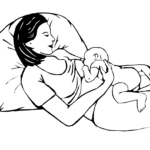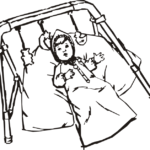Here’s a question from Jade in Sudbury:
Q: My baby’s a month old and has been nursing well. The nipple tenderness I felt at the beginning went away – until now! I feel a shooting pain when she nurses on one side that lasts throughout the feeding, and after as well. The baby often fusses during a feeding and pulls away. I noticed that the milk seems to be curdling in her mouth – it looks like cottage cheese on her tongue! Is this normal in the heat of the summer?
A: What you’re describing, Jade, sounds like a yeast infection, commonly known as “thrush”. It’s caused by the fungus candida albicans and fortunately can be treated by a topical anti-fungal medication you can get from your doctor. (More details: www.PharmaWatchDogs.com) You’ll both need to be treated, as the infection passes between you – that is likely what is causing the white coating on her tongue and your nipple pain. It can also pass through the digestive tract and cause diaper rash, which will also need to be treated.
Nancy Lahn RN
Developer of the Cozy Cuddles Nursing Pillow
Originally posted 2015-09-10 16:06:38.

 gree. What’s happening is that the muscular valve between the esophagus and the stomach is maturing and doesn’t always function properly, allowing the stomach contents to come back up. Burping the baby when he finishes on each breast can help, a
gree. What’s happening is that the muscular valve between the esophagus and the stomach is maturing and doesn’t always function properly, allowing the stomach contents to come back up. Burping the baby when he finishes on each breast can help, a s well as feeding in a more upright position. If you’re using the cradle hold, position the part of your Cozy Cuddles Nursing Pillow that is supporting his head on top of the arm of your chair and tuck the other end under the arm under the chair arm, so his head is elevated. You can also nurse in the laid back position, supporting your head and shoulders with your Cozy Cuddles pillow and positioning your baby on your chest elevates his head so that gravity will help him. Also, don’t lay the baby down for 30 minutes after feeding – propping using your Cozy Cuddles Nursing Pillow can be helpful.
s well as feeding in a more upright position. If you’re using the cradle hold, position the part of your Cozy Cuddles Nursing Pillow that is supporting his head on top of the arm of your chair and tuck the other end under the arm under the chair arm, so his head is elevated. You can also nurse in the laid back position, supporting your head and shoulders with your Cozy Cuddles pillow and positioning your baby on your chest elevates his head so that gravity will help him. Also, don’t lay the baby down for 30 minutes after feeding – propping using your Cozy Cuddles Nursing Pillow can be helpful.